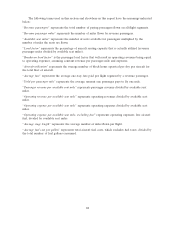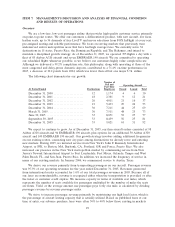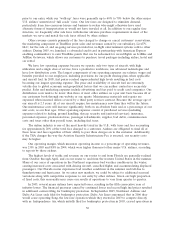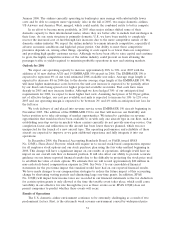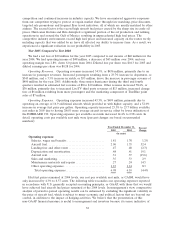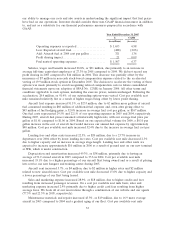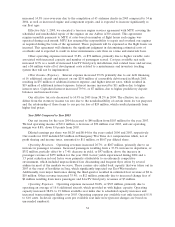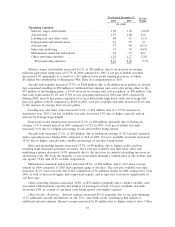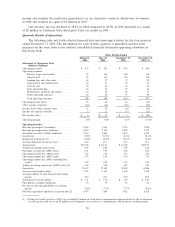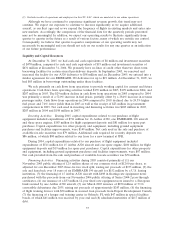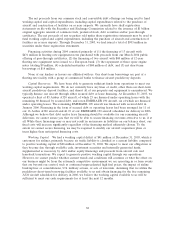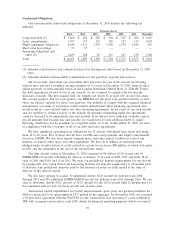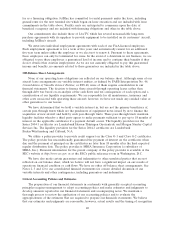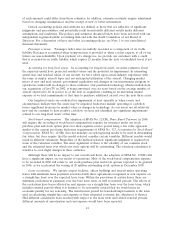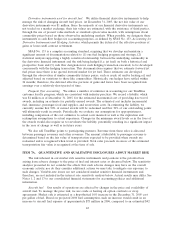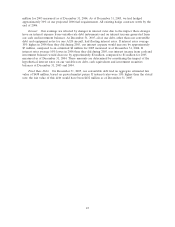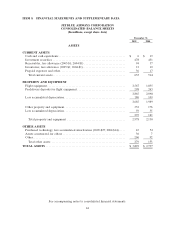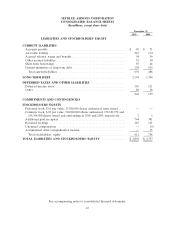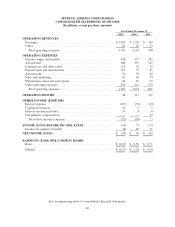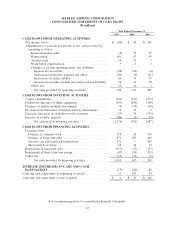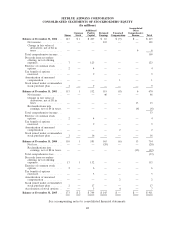JetBlue Airlines 2005 Annual Report Download - page 46
Download and view the complete annual report
Please find page 46 of the 2005 JetBlue Airlines annual report below. You can navigate through the pages in the report by either clicking on the pages listed below, or by using the keyword search tool below to find specific information within the annual report.The net proceeds from our common stock and convertible debt offerings are being used to fund
working capital and capital expenditures, including capital expenditures related to the purchase of
aircraft and construction of facilities on or near airports. We currently have shelf registration
statements on file with the Securities and Exchange Commission related to the issuance of $1 billion
original aggregate amount of common stock, preferred stock, debt securities and/or pass-through
certificates. The net proceeds of any securities sold under these registration statements may be used to
fund working capital and capital expenditures, including the purchase of aircraft and construction of
facilities on or near airports. Through December 31, 2005, we had issued a total of $903 million in
securities under these registration statements.
Financing activities during 2004 consisted primarily of (1) the financing of 13 aircraft with
$431 million in floating rate equipment notes purchased with proceeds from our March 2004 public
offering of pass-through certificates, (2) the financing of two aircraft with $68 million of 12-year
floating rate equipment notes issued to a European bank, (3) the repayment of three spare engine
notes totaling $9 million, (4) scheduled maturities of $68 million of debt, and (5) net short-term
borrowings of $14 million.
None of our lenders or lessors are affiliated with us. Our short-term borrowings are part of a
floating rate facility with a group of commercial banks to finance aircraft predelivery deposits.
Capital Resources. We have been able to generate sufficient funds from operations to meet our
working capital requirements. We do not currently have any lines of credit, other than our short-term
aircraft predelivery deposit facilities, and almost all of our property and equipment is encumbered. We
typically finance our aircraft through either secured debt or lease financing. At December 31, 2005, we
operated a fleet of 85 Airbus A320 aircraft, of which 25 are financed under operating leases with the
remaining 60 financed by secured debt, and seven EMBRAER 190 aircraft, six of which are financed
under operating leases. The remaining EMBRAER 190 aircraft was financed with secured debt in
January 2006. Financing in the form of secured debt or operating leases had been arranged for 11 of
our 16 Airbus A320 aircraft and all 19 of our EMBRAER 190 aircraft scheduled for delivery in 2006.
Although we believe that debt and/or lease financing should be available for our remaining aircraft
deliveries, we cannot assure you that we will be able to secure financing on terms attractive to us, if at
all. While these financings may or may not result in an increase in liabilities on our balance sheet, our
fixed costs will increase significantly regardless of the financing method ultimately chosen. To the
extent we cannot secure financing, we may be required to modify our aircraft acquisition plans or
incur higher than anticipated financing costs.
Working Capital. We had a working capital deficit of $41 million at December 31, 2005, which is
customary for airlines, primarily because air traffic liability is classified as a current liability, compared
to positive working capital of $26 million at December 31, 2004. We expect to meet our obligations as
they become due through available cash, investment securities and internally generated funds,
supplemented as necessary by debt and/or equity financings and proceeds from aircraft sale and
leaseback transactions. We expect to generate positive working capital through our operations.
However, we cannot predict whether current trends and conditions will continue or what the effect on
our business might be from the extremely competitive environment we are operating in or from events
that are beyond our control, such as continued unprecedented high fuel prices, the impact of airline
bankruptcies or consolidations, U.S. military actions, or acts of terrorism. Assuming that we utilize the
predelivery short-term borrowing facilities available to us and obtain financing for the five remaining
A320 aircraft scheduled for delivery in 2006, we believe the working capital available to us will be
sufficient to meet our cash requirements for at least the next 12 months.
38


